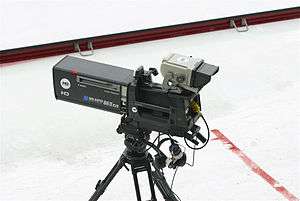Video camera

A video camera is a camera used for electronic motion picture acquisition (as opposed to a movie camera, which records images on film), initially developed for the television industry but now common in other applications as well.
The earliest video cameras were those of John Logie Baird, based on the mechanical Nipkow disk and used in experimental broadcasts through the 1920s-30s. All-electronic designs based on the video camera tube, such as Vladimir Zworykin's Iconoscope and Philo Farnsworth's image dissector, supplanted the Baird system by the 1930. These remained in wide use until the 1980s, when cameras based on solid-state image sensors such as CCDs (and later CMOS active pixel sensors) eliminated common problems with tube technologies such as image burn-in and made digital video workflow practical. The transition to digital TV gave a boost to digital video cameras and by the 2010s, most video cameras were digital.
With the advent of digital video capture, the distinction between professional video cameras and movie cameras has disappeared as the intermittent mechanism has become the same. Nowadays, mid-range cameras exclusively used for television and other work (except movies) are termed professional video cameras.
Video cameras are used primarily in two modes. The first, characteristic of much early broadcasting, is live television, where the camera feeds real time images directly to a screen for immediate observation. A few cameras still serve live television production, but most live connections are for security, military/tactical, and industrial operations where surreptitious or remote viewing is required. In the second mode the images are recorded to a storage device for archiving or further processing; for many years, videotape was the primary format used for this purpose, but was gradually supplanted by optical disc, hard disk, and then flash memory. Recorded video is used in television production, and more often surveillance and monitoring tasks in which unattended recording of a situation is required for later analysis.
Modern video cameras have numerous designs and uses.
- Professional video cameras, such as those used in television production, may be television studio-based or mobile in the case of an electronic field production (EFP). Such cameras generally offer extremely fine-grained manual control for the camera operator, often to the exclusion of automated operation. They usually use three sensors to separately record red, green and blue.
- Camcorders combine a camera and a VCR or other recording device in one unit; these are mobile, and were widely used for television production, home movies, electronic news gathering (ENG) (including citizen journalism), and similar applications. Since the transition to digital video cameras, most cameras have in-built recording media and as such are also camcorders.
- Closed-circuit television (CCTV) generally uses pan tilt zoom cameras (PTZ), for security, surveillance, and/or monitoring purposes. Such cameras are designed to be small, easily hidden, and able to operate unattended; those used in industrial or scientific settings are often meant for use in environments that are normally inaccessible or uncomfortable for humans, and are therefore hardened for such hostile environments (e.g. radiation, high heat, or toxic chemical exposure).
- Webcams are video cameras which stream a live video feed to a computer.
- Camera phones - nowadays most video cameras are incorporated into mobile phones.
- Special camera systems are used for scientific research, e.g. on board a satellite or a spaceprobe, in artificial intelligence and robotics research, and in medical use. Such cameras are often tuned for non-visible radiation for infrared (for night vision and heat sensing) or X-ray (for medical and video astronomy use).
See also
- Digital single-lens reflex camera
- FireWire camera
- Professional video camera
- Radar imaging
- Recording at the edge
- Television production
- Three-CCD
- Video camera tube
- Videograph
- Videotelephony
References
External links
 Media related to Video cameras at Wikimedia Commons
Media related to Video cameras at Wikimedia Commons The dictionary definition of video camera at Wiktionary
The dictionary definition of video camera at Wiktionary
| ||||||||||||||||||||||||||||||||||||||||||||||||||||||||||||||||||||||||||||||||||||||||||||||||||||||||||||||
|